Nikki Hiltz Is On A Hot Streak. It's Years In the Making.
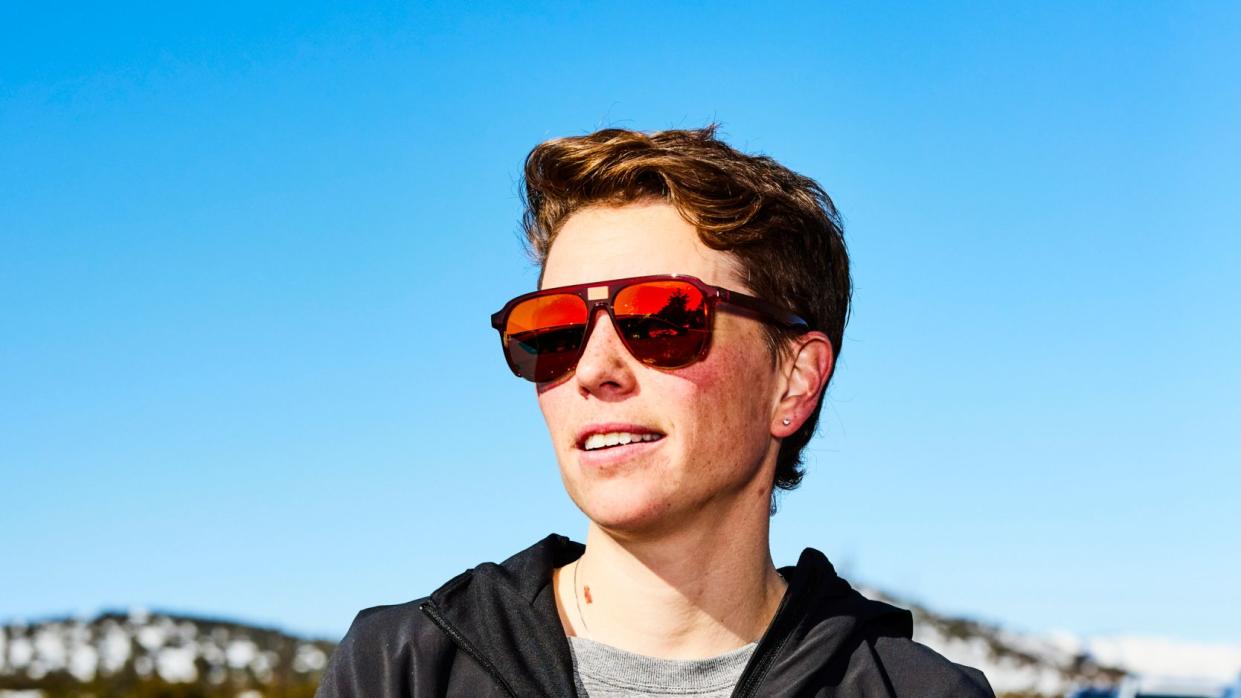
- Oops!Something went wrong.Please try again later.
February 18, 2023. Albuquerque, New Mexico. Nikki Hiltz is on the starting line of the women’s 1500m at the USA Track & Field Indoor Championships, struggling to concentrate.
Hiltz is under a lot of pressure, most of it self-inflicted. They’d shown up to the meet toggling between two states of mind: really wanting to win, and wondering why they were even there.
Still frustrated after a seventh-place finish at the Millrose Games the week before, despite a solid pace—4:24.68—Hiltz is trying to forget about last week and get their head in the game.
Don’t focus on what the number on the clock will read when you cross the finish line, just race.
The group goes out slowly, which means that the last couple of laps will be fast. Hiltz closes the final 400m in 58.86.
Approaching the last lap, Hiltz moves up onto the high side of the bank to close the gap to Sage Hurta-Klecker, who leads by several strides.
The two runners enter the final stretch, stride-for-stride, until the very last moment, when Hiltz hurtles forward—a signature Nikki Hiltz kick.
With a time of 4:17.10, Hiltz wins the women’s 1500m and becomes the first openly non-binary athlete to earn a USA Track & Field national title. They break the tape with a giant, cheesy smile.
“I’m the first, I hope, of many in the generations to come,” Hiltz later tells me.
• • •
“Did you see the moon last night?” Hiltz asks me. It’s the morning after the full moon in Gemini during Sagittarius season, and Hiltz left a glass of water outside to charge under the moon (a common astrological practice to harness the connection between the moon and the tides). Hiltz’s moon and rising signs are Gemini, known for duality and quick thinking.
I am meeting Hiltz at a coffee shop in Flagstaff, Arizona, in December. Hiltz wears khaki-colored track pants, a lavender T-shirt, and a fanny pack slung across their body, messenger-bag style. Their short, sandy hair, cut like an early-aughts boy-band heartthrob, is covered with a gray beanie. Freckles dust the bridge of their nose.
It is 20 degrees out, and a thin layer of snow covers the ground in town and along Route 66. The white-capped mountains in the distance surround the city of approximately 76,000 people.
Hiltz is quiet but not soft-spoken, outgoing and extroverted but conflict-averse. They hate making people uncomfortable or drawing attention to themself, and they struggle with the idea that asking race directors and media members to respect their identity makes them a burden.
Emma Gee is also there; the two met via Instagram DM and have been dating for three years. They live together in Flagstaff with their German shepherd, Scout. Throughout our conversation, Gee—a Leo, and an elite runner herself—often interrupts to provide context. She wants to make sure that Hiltz is acknowledging the credit they deserve.
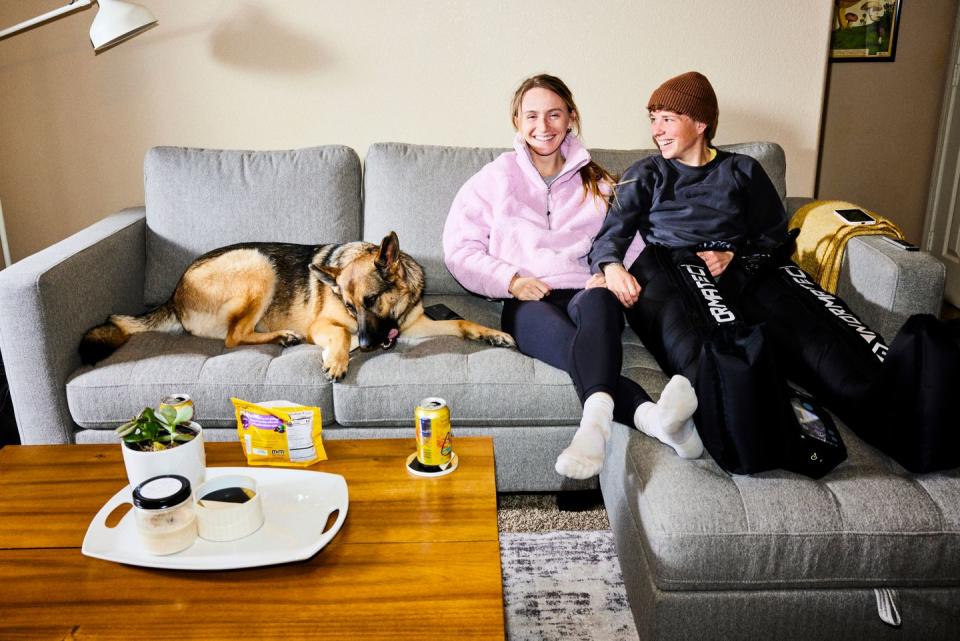
After a tumultuous few years of professional racing, Hiltz is learning the power of taking up space in the sport. “It’s not easy for you to be in conflict in this way with people,” Gee says, speaking directly to her partner across the table. “People may not know that this doesn’t come naturally to you, and honestly, it kind of makes it more special.”
Nikki Hiltz was born October 23, 1994—a Scorpio—and grew up in Aptos, California, just outside Santa Cruz. At Aptos High School, they were a breakout track athlete. “Each year I got better,” Hiltz says. “My sophomore year, I made it to state and I got third, which at that age was a big deal.” They had one of the top times in the country that year, a 4:43 in the 1600m. “My high school coach looked at my mom and was like, ‘Nikki just got their college paid for.’”
In fact, after becoming the California state women’s 1600m champion in 2012, Hiltz earned a track scholarship to the University of Oregon, and dreamed of being the next Steve Prefontaine. But almost immediately after the school year started, Hiltz sustained a tarsal navicular bone stress fracture, which required surgery and took them out of competition. After two years, they transferred to the University of Arkansas to finish out their last three years of eligibility, and began competing in earnest, hoping to eventually go pro.
And yet each season, Hiltz felt the dream slipping away. They were making NCAA championships, but not getting professional-level results. They had hoped to make the Olympic Trials in 2016, and then didn’t even come close to qualifying. “It was this moment of, ‘Oh, maybe I won’t be able to do that,’” says Hiltz.
For Hiltz, running had always been a distraction from confronting certain truths, but while benched after surgery at University of Oregon, they had time to reflect and acknowledge their queer identity. “It kind of forced me to face these feelings,” Hiltz says. “I was like, ‘It’s time to deal with this.’”
Now, in 2016, with the prospect of professional running fading into the distance, “I kind of slowly came out to people around me, and then that summer I came out to my parents, and that fall, to my teammates,” Hiltz says.
Afterward, something unexpected happened: Everything turned around, as if the freedom Hiltz felt from being fully out reverberated onto the track. “By the time I had exhausted my collegiate eligibility, I had earned seven All-American honors, including two runner-up finishes in the 1500m at the NCAA championships,” Hiltz wrote in an April 2021 op-ed for Runner’s World. “That led to 2018, when I signed a shoe contract with Adidas and became a professional runner, turning my passion into my career.”
Hiltz moved back to California, settling this time in San Diego, joined a pro group, and had a dream rookie season: gold at the Pan Am Games; first at the USATF 1 Mile Road Championships, setting the course record; third in the 1500m at USATF Outdoor Championships, qualifying for the World Final in Doha.
But when lockdowns began in 2020, Hiltz’s training group fell apart. With running once again on the back burner, Hiltz killed time by scrolling TikTok, and discovered a world of queer and trans people who looked how they looked—or how they wanted to look—and terminology that finally described their internal experience. “I think the app knew I was non-binary before I did,” Hiltz says.
On March 31, 2021, the International Transgender Day of Visibility, Hiltz came out publicly as transgender non-binary.
“I have a very distinct memory from my sixth birthday,” Hiltz wrote in the Runner’s World piece. “When I blew out the candles on my birthday cake, I wished that the next morning, I would wake up a boy.
“Six-year-old me expressed my gender identity through having short hair, wearing baseball caps, and refusing to wear dresses. I felt most like myself when I was playing football with the boys during recess, when my dad called me Nick instead of Nikki, and when the substitute teachers would mistake me for a boy.
“What I didn’t know then was how to explain that my gender identity differs from the sex I was assigned at birth. While I’ve felt this way my whole life, I only recently came out about it publicly.”
Support rolled in on social media. And Hiltz had expected to feel the same kind of freedom after coming out that had, in part, driven the success of their early career. Then came the backlash—hateful comments on social media, misgendering from race directors and media. Hiltz was not prepared for the level of hostility.
They had been out publicly for just two months before the Olympic Trials in Eugene, Oregon, in June of 2021. Expectations were high. “Running is so mental, and you want to be calm and confident,” Hiltz says. “I wasn’t either of those things. But I was fit enough to fake it.”
The Trials are three rounds. Hiltz, wearing a two-piece, blue leopard-print running set, sailed through their first-round heat. Halfway through their semi-final heat, they were in sixth. With one lap remaining, they accelerated into second, and then, with their signature kick, pulled off a win, flashing two peace signs across the finish line with the fastest time of any runner in the two semi-final heats, 4:05.87. All that was left to clinch an Olympic spot was to get top-three, two days later in the last round.
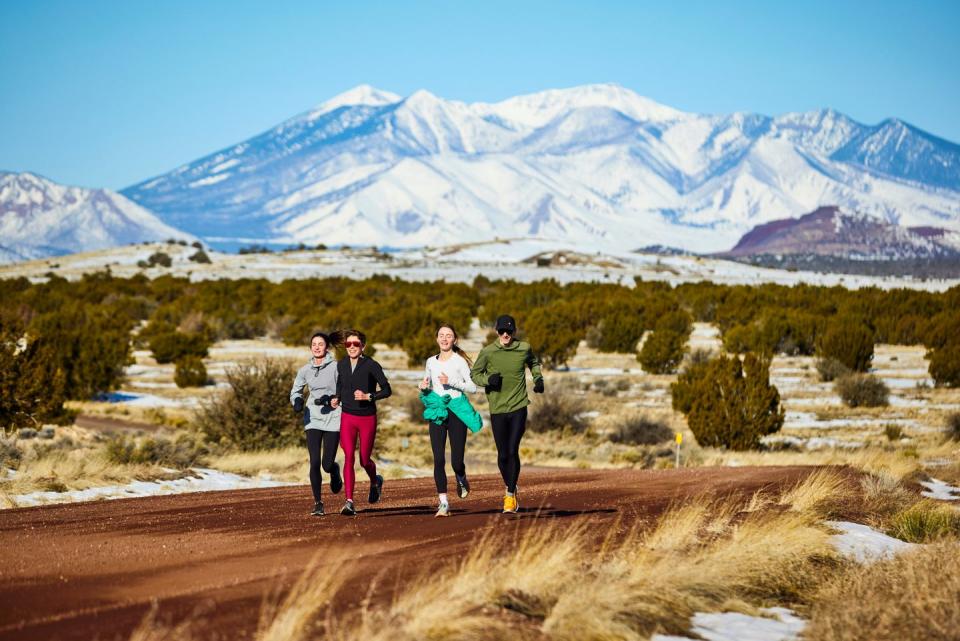
At the finals, nothing felt right. As announcers encouraged viewers to “keep an eye on Nikki Hiltz,” things fell apart almost immediately. Less than 10 seconds into the race, the group consolidated into a tight pack. A runner stumbled, creating a domino effect: one runner bumped another, who bumped Hiltz, who pushed another runner off the track. The audience groaned. Mentally, Hiltz never recovered and finished last.
It was profoundly disappointing. “This is something that comes around once every four years,” Hiltz says. “It’s something I’d been working towards, a dream I’ve always had.”
The night before the last round, Hiltz had been up until 4 in the morning coughing. “I feel like it was stress-induced sickness,” Hiltz says. “I was scared, vulnerable.” Few have ever tried to qualify for the Olympics as an openly non-binary athlete in a sport that perhaps did not know how to support them. “Subconsciously I think I wanted to do this not only for me, but for the LGBTQ community. But no one was putting [that pressure] on me except for myself.”
Hiltz had hoped that coming out as trans non-binary would show other members of the community that you could be yourself and have success in your sport. To be the person they needed to see in the world growing up. But the burden of representation may have been too much.
• • •
Hiltz’s 1500m victory at the USATF Indoor Championships in February was a moment, perhaps, of relief. The relief of being one thing for one moment. So much is asked of trailblazers. Hiltz’s very existence requires them to hold many things at once: an athlete and an advocate, existing both within and outside of the gender binary; a self-identified king racing in the women’s division. There is joy in crossing the finish line as the first person doing it in a body like theirs. In that moment, they exist simply as a champion. In that moment in February, Hiltz was whole.
After that victory, Hiltz’s hot streak continued. The outdoor season began in Azusa, California, in April, at the Bryan Clay Invitational, with an 800m race they’d run four years before, setting a personal best of 2:01.3. Hiltz has spent the last four years trying to break the two-minute mark in the 800m. This time, they decided to put the goal aside.
Hiltz stuck to their tried-and-true strategy: biding time, not getting out in front, relying on that late-race kick. They slowly moved up in the race until the finish was within sight. They were right behind the leader, Louisiana State University’s Michaela Rose. Rose was on the inside edge of the group, with seemingly no room for Hiltz to get around her. Then somehow, barely on the track, Hiltz squeezed around Rose on the inside, crossing the line just ahead of her, before tumbling onto the infield. The final time on the clock: 1:59.03.
Less than two weeks later, Hiltz used the same sit-and-kick strategy to win the USATF 1 Mile Road Championships in Des Moines, Iowa. Hiltz was draped in an American flag and a pride flag. “Trans people live in Iowa, trans people are everywhere, and they deserve access to healthcare, access to sports,” Hiltz told a Citius Mag reporter, with tears in their eyes.
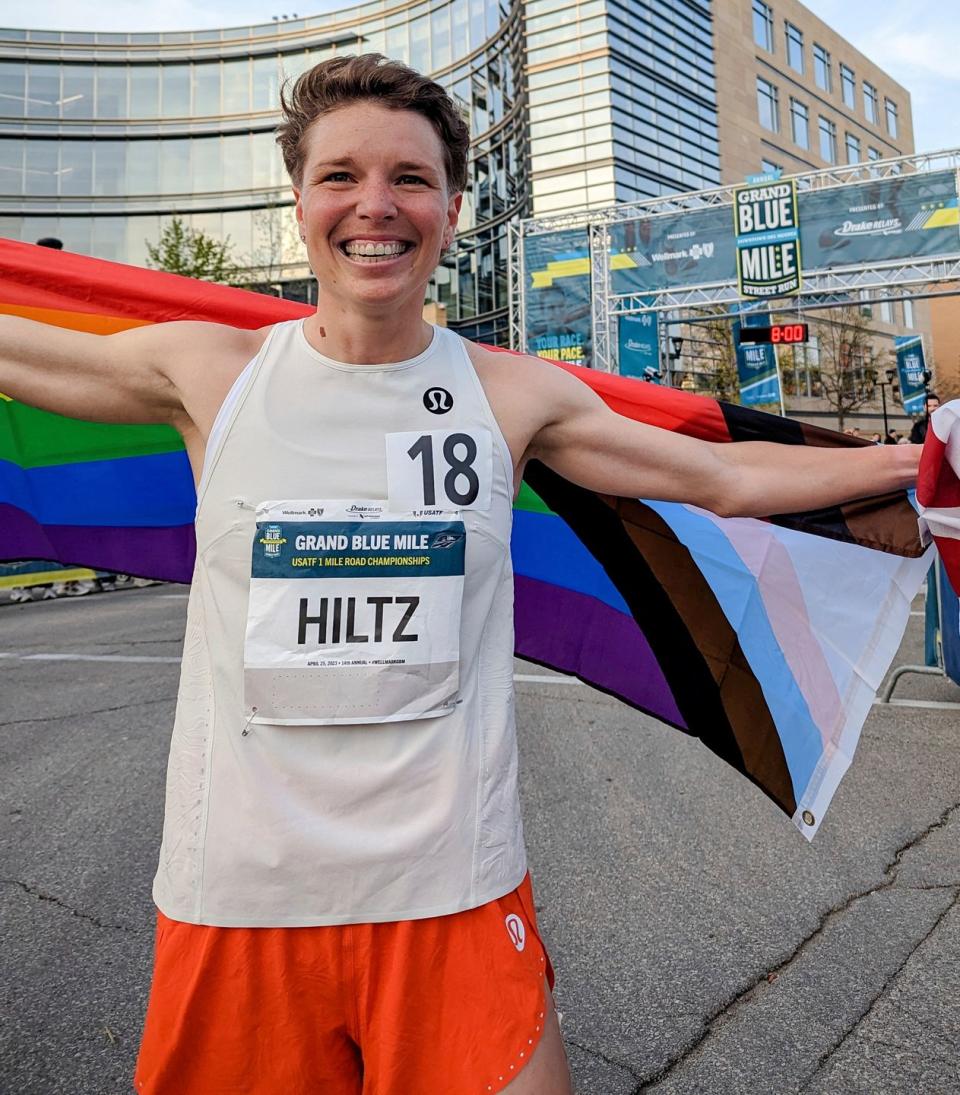
Hiltz has been racing in Europe this spring, with top results: first in a mile and second in a 1500m in France; first in a 1500m in Norway. In Oslo, they competed in their first Diamond League, an elite series of races. Hiltz ran a 4:18.38 mile—their personal best.
“Momentum is everything in this sport,” Hiltz wrote on Instagram. “From my Flagstaff family, to my brands, to the people who raised me, to the entire queer community, y’all are my why and the reason I’m able to thrive.”
• • •
In March of 2022, Hiltz, Gee, and Scout moved to Flagstaff to train with Mike Smith, the track coach at Northern Arizona University. “The U.S. championships are in June,” Hiltz says. “I only had three months to adjust to altitude, get really fit, and try to perform as best I can because I was also under this pressure to get a contract.”
Pro contracts are often performance-based with bonuses for things like running a certain time or making a certain team. In essence, the better an athlete performs, the more value they have to a company. But for an athlete like Hiltz, their value extends off the track.
“Every Pride Month, [Adidas] asked me to come out and do a shoe or do this podcast or post this and that, and I was like, ‘So pay me for these things.’ They’re like, ‘But you ran worse in 2021 than you did in 2018.’” In 2021, Hiltz chose not to re-sign with Adidas, which meant no financial support for a couple of months.
Lululemon, a relative newcomer to athlete sponsorship, made a compelling offer. “They’re like, ‘We’ll always be rooting for you to chase your dreams of being an Olympian. But we care about what you’re doing off the track way more.” Hiltz announced the “dream partnership” at the end of Pride Month 2022, just ahead of the USATF Outdoor Championships.
With a new home base, the support of a new coach, and finally a new sponsor, Hiltz has been able to expand their advocacy work as well. In 2020, at the height of the pandemic, Hiltz had founded Pride 5K, a virtual race for LGBTQ+ people and allies. Nearly 2,000 people signed up to race and the event raised $33,000 for The Trevor Project, a crisis support service for young LGBTQ+ people. In October 2022, the race was finally held in-person in Flagstaff. More than 200 people participated and raised $37,000; Lululemon donated prize money for the elite racers.
Track and field as a whole is beginning to give real thought to what true inclusion could look like. Some major marathons now have a non-binary category, and New York Road Runners allows runners like Hiltz to have an “X” as their gender marker but still choose to compete in the women’s division.
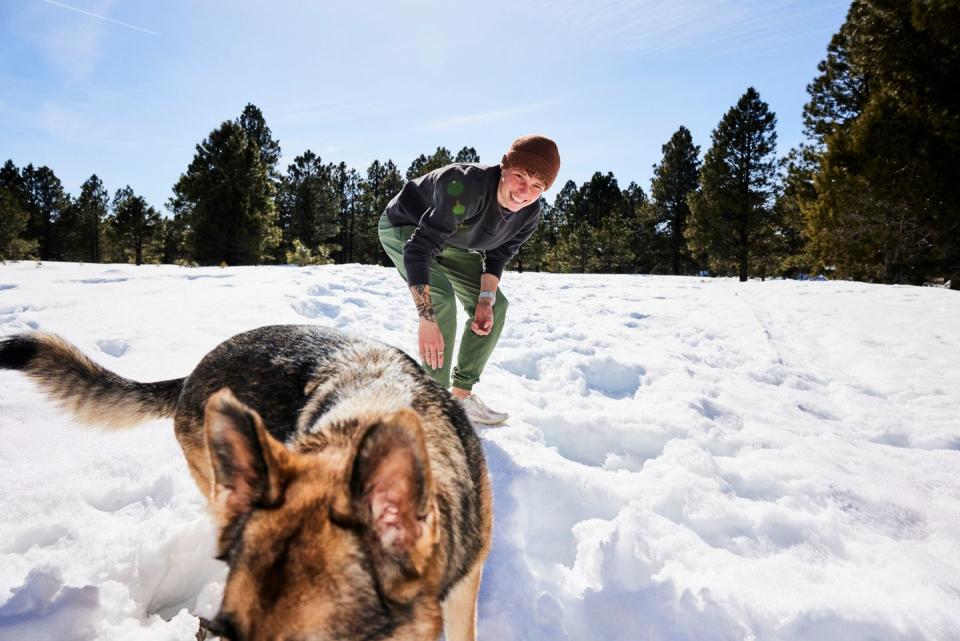
“But when it comes to the elite races,” Hiltz says, “I’m obviously the only [openly non-binary] person there. If I register as non-binary, I would not want the men to have their whole race, the women to run their whole race, and then just me on the starting line. What are you saying if you do that?”
Meanwhile, the spate of anti-trans bills sweeping the country is affecting the perception of who trans athletes are and what kind of so-called threat they pose to the cisgender women who also compete.
Track and field is governed by World Athletics at the international elite level. World Athletics long held one of the most restrictive trans exclusion policies in sports, with one of the lowest testosterone levels required to compete in the women’s division, even for cisgender women. In March, they outright banned trans women from participating in international competitions.
These policies largely and most severely affect transgender women, but they also extend to non-binary athletes. Hiltz does not take testosterone, and doesn’t plan to as long as they compete as a pro runner. There are plenty of sacrifices pro athletes make for their sports, but when those sacrifices affect the very core of one’s identity, the stakes become much higher. The sports world—and the world at large—can feel hostile to the very reality of who you are as a person. That’s scary and demoralizing and, as Hiltz experienced, potentially detrimental to performance.
Where Hiltz once loved seeing other trans people on social media documenting their journeys with top surgery or hormone replacement therapy, those videos are now a point of sadness, knowing that it is not currently possible for them. “Going to the Olympics is such a dream of mine,” Hiltz says. “But it’s also such a dream of mine to take testosterone or grow facial hair or have top surgery, and so I think sometimes I can really resent this sport.”
So many athletes struggle when they retire, not knowing who they are or what they are going to do with their time. But not Hiltz: “I know exactly what I’m gonna do. I can take testosterone.”
• • •
The day I spend with Hiltz is a Thursday, and after our morning coffee, we meet at the NAU track later that afternoon with several of their training partners. The group is talking about the previous night’s full moon and the various rituals they did to harness the moon’s energy.
The vibe is light—Coach Smith isn’t there today—and the conversation between the athletes flows easily. Hiltz fit right in with this group of runners from day one. “Nikki has been so open and has this childlike energy that really encompasses wanting to have a good time and also wanting to make sure that everyone feels accepted and understood and loved,” Elly Henes, a 5K runner, says. “Nikki is always going to bring their A-game,” says Rachel Smith, another training partner, “so they’re elevating us, especially from a speed and intensity standpoint.”
Thursdays are usually for “hills and drills,” but Hiltz is only doing the drills on this day, as they are leaving the next morning for Hawaii, where they will be running the Kalakaua Merrie Mile in Waikiki. It’s an integrated race, one branded as a “gender challenge,” where the athletes competing in the women’s category get a 29-second head start ahead of the men. The first to cross the finish line, irrespective of gender, wins.
In the hotel room before the race, Hiltz and Gee get ready together. Gee is doing the community race, which takes place 45 minutes before the pros. They are both wearing single-color Lululemon sets, giving a sort of queer Barbie and Ken vibe: Gee in a hot pink tank top and matching shorts, Hiltz in a lavender version with a muscle tank. Talking into a camera for a vlog, Hiltz asks Gee about her goals for her race.
“You could be looking at a sub-five miler later today,” Hiltz says, as they pin on their race bib. “Is that you?” Gee asks. “No, you,” Hiltz says, as they both laugh. “Yeah, actually, I’m just trying to break five in my race, too.”
Hiltz fastens Gee’s bib to her shirt, they make a plan to meet up after their races, snap a selfie, then share a kiss. Gee leaves to run her race and Hiltz snacks on a banana. “I saw Johnny Gregorek eat a banana before a race one time and then he ran 3:49,” Hiltz says, referencing Mean Girls, into the camera, “so now I eat a banana before every race.”
The race takes place next to Waikiki Beach, on a warm, windy Saturday in December. The elite athletes walk over from their hotel together; no one’s as prepared as they’d like to be, as the mile season hasn’t technically started yet. “Who knows what shape anyone’s in,” Hiltz says, “but I’m excited to race the guys and the girls.”
The women take off and Hiltz and Sage Hurta-Klecker set a strong pace. The announcer speculates that “this could be the year” a woman wins it all. By about 900m into the race, the men’s field had made up nearly half the distance.
As the race closes out, the leading men just manage to overtake the leading runners in the women’s division. Then, all at once, a throng of runners of all genders cross the finish line. Hiltz is grinning. Neil Gourley wins with a time of 3:56.1, and Hiltz comes in thirteenth overall, running 4:27.43.
After the race, Hiltz relaxes with Gee—who ran her mile in under five minutes—and debriefs. Hiltz shares the results on social media: “This one’s for all the trolls in my DMs who ask, ‘Why don’t you ever race the men?’” The next day the couple cheers on Honolulu Marathon runners and goes for a hike. In an Instagram reel, Hiltz documents a joy-filled weekend that includes a casual run, a boat ride with friends, and wearing a Hawaiian shirt against a backdrop of palm trees.
When Hiltz and Gee return home, it’s cold and snowing in Flagstaff. But they’ve seen a glimpse of the kind of future that Hiltz is racing toward—and prepared to win.
You Might Also Like

